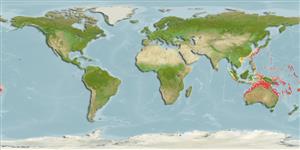Common names from other countries
Classification / Names / Names
Nomi Comuni | Sinonimi | Catalog of Fishes (gen., sp.) | ITIS | CoL | WoRMS
Environment: milieu / climate zone / depth range / distribution range
Ecologia
; distribuzione batimetrica 18 - 78 m (Ref. 100335), usually 30 - 60 m (Ref. 117225). Tropical
Indo-West Pacific: Australia, Philippines and New Caledonia.
Length at first maturity / Size / Peso / Age
Maturity: Lm ? range ? - ? cm Max length : 5.0 cm ShH maschio/sesso non determinato; (Ref. 821)
Length based on occurence record; to be replaced with better reference.
Life cycle and mating behavior
Maturità | Riproduzione | Deposizione | Uova | Fecundity | Larve
Members of the order Neotaenioglossa are mostly gonochoric and broadcast spawners. Life cycle: Embryos develop into planktonic trocophore larvae and later into juvenile veligers before becoming fully grown adults.
Springsteen, F.J. and F.M. Leobrera. 1986. (Ref. 821)
IUCN Red List Status (Ref. 130435)
CITES status (Ref. 108899)
Not Evaluated
Not Evaluated
Human uses
| FishSource |
Strumenti
Informazioni ulteriori
Age/SizeAccrescimentoLength-weightLength-lengthMorfologiaLarveAbbondanza
Fonti Internet
Estimates based on models
Preferred temperature
(Ref.
115969): 24.6 - 28.5, mean 27.3 (based on 107 cells).
Vulnerability
Low vulnerability (10 of 100).
